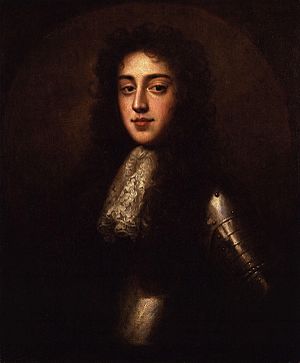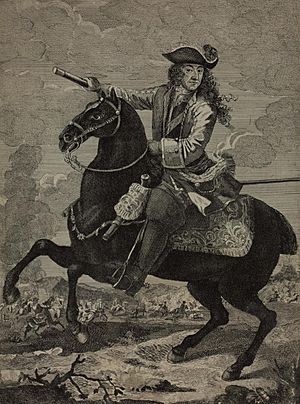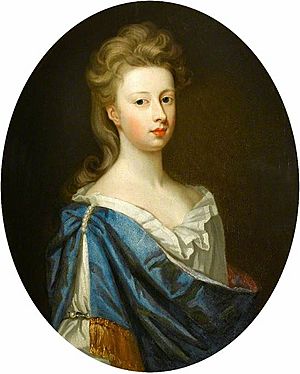John Cutts, 1st Baron Cutts facts for kids
Quick facts for kids
The Lord Cutts
|
|
|---|---|

Lord Cutts
|
|
| Born | 1661 |
| Died | 25 January 1707 |
| Allegiance | |
| Service/ |
British Army |
| Rank | Lieutenant-General |
| Commands held | Ireland |
| Battles/wars | Williamite War in Ireland Nine Years' War War of the Spanish Succession |
Lieutenant-General John Cutts, 1st Baron Cutts (born 1661 – died 25 January 1707) was a brave British soldier and a talented writer. He was known for his courage in battle and his love for poetry.
Contents
Early Life and Beginnings
John Cutts was born around 1661 in Arkesden, Essex, England. He was the second son of Richard Cutte and Joan Everard. His family had a history of serving the English crown. For example, an ancestor, Sir John Cutts, worked for King Henry VIII.
John went to Catharine Hall at Cambridge University. Even though he inherited family lands, he was more interested in life at court and in the army.
A Soldier's and Poet's Career
John Cutts had two big dreams: to be famous as a soldier and as a writer. In 1685, he published his first book, La Muse de cavalier. This book showed his love for poetry.
Early Military Adventures
The next year, in 1686, Cutts joined the army as a volunteer in Hungary. He fought under the Duke of Lorraine. It is said that he was the first to put the imperial flag on the walls during the storming of Buda. This was a very brave act.
In 1687, he published another book of poems called Poetical Exercises. The following year, he was serving as a lieutenant-colonel in Holland. A general named Hugh Mackay described Cutts as "tall, strong, and well-shaped." He also said Cutts was "an agreeable companion with a lot of wit."
Fighting for William III
Lieutenant-Colonel Cutts was a close friend of William III. He joined William during the Revolution of 1688 in England. In 1690, he led a regiment of soldiers in Ireland. He fought very well there.
He showed great bravery at the Battle of the Boyne in July 1690. He was also wounded during the siege of Limerick (1690). Because of his excellent service, King William made him Baron Cutts on 12 December 1690. This gave him a special title in Ireland.
In 1691, he took command of a brigade after its leader was wounded at the Battle of Aughrim. When Limerick surrendered, he became the commander of the town. The next year, he fought in Flanders. His brigade suffered heavy losses at the Battle of Steinkirk in August 1692, where Cutts himself was wounded.
The "Salamander"
For a while, Lord Cutts was the lieutenant-governor of the Isle of Wight (from 1694 to 1707). But he returned to active duty in 1694. He took part in the difficult Brest expedition in June 1694. He was wounded again during this time.
Cutts became the colonel of the Coldstream Guards. He later fought bravely at the famous Siege of Namur (1695). Here, he earned the nickname "Salamander." This was because he seemed not to care about the heaviest enemy fire. He was shot in the head while leading an attack but recovered quickly. He then led his men to capture the enemy's defenses.
Diplomacy and Later Battles
After this, Cutts often switched between serving at court and fighting in wars. King William III trusted him deeply. Cutts helped with the talks that led to the Peace of Ryswick in 1697. When a big fire happened in Whitehall in 1698, Cutts led his Coldstream Guards. He again showed his bravery, proving why he was called "the Salamander." Later, Captain Richard Steele worked as his private secretary.
In 1702, as a major-general, Cutts served under Marlborough. This was during the start of the War of the Spanish Succession. At the 1702 siege of Venlo, he was very brave. He led the attack on Fort Saint Michael. Even his enemies were surprised by his success in such a risky plan. The writer Jonathan Swift even wrote a poem about him called Ode to a Salamander.
Cutts fought in Flanders in 1703. In 1704, he joined Marlborough again near the Danube river. At the Battle of Blenheim in August 1704, he was third in command. His division fought very hard in the village that gave the battle its name. Blenheim was his last battle. On 23 March 1705, he was made Commander-in-Chief, Ireland. He held this important position until he died.
Later Life and Legacy
John Cutts spent his last years at home. When he died, he held eight different important jobs in politics and the military. He was a member of Parliament for Cambridge county five times. Later, he represented Newport in the Isle of Wight for Queen Anne's first Parliament until his death.
He was married twice but did not have any children.
In January 2007, his old college, St Catharine's, held a special dinner. This event remembered John Cutts 300 years after his death.



